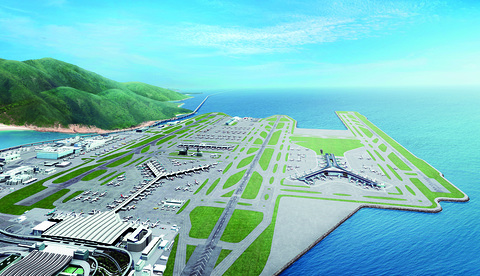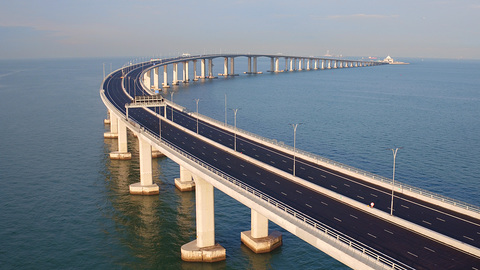Invest in Hong Kong's infrastructure with vision
7 October 2018
Despite its small size, Hong Kong has developed from a quiet fishing village into a cosmopolitan city of Asia today through continuous transformation.
In retrospect, our major infrastructure projects in each era were all aligned with the social development and needs at the time. The Government’s investment in infrastructure was sometimes criticised as a waste of public money on “white elephant” projects in which people only see harm but not benefits. When we look back now, however, the facts speak louder than words.
During the construction of the mass transit railway (MTR) in the 1970s, some people also questioned its necessity and others doubted its safety. Today, Hong Kong boasts a modern and highly-efficient railway system with a daily ridership of more than 5.3 million.
The MTR now operates ten commuter rail lines and the Airport Express. The sophisticated rail network covers Hong Kong Island, Kowloon and the New Territories, in addition to its Light Rail serving the Tuen Mun and Yuen Long communities. Can you imagine what our life would be like without the MTR?
The Hong Kong International Airport at Chek Lap Kok has achieved remarkable success in its 20 years of operation and contributed greatly to the aviation development of Hong Kong. As an international and regional aviation hub, our city has topped the world’s list in air cargo throughput for eight consecutive years and ranked third in international passenger throughput.
 |
On aviation, there are currently about 1 100 daily flights connecting Hong Kong to around 220 destinations worldwide, including some 50 destinations in Mainland China. We are committed to consolidating our position as a leading international and regional aviation hub. The construction of the three-runway system (3RS), started by the Airport Authority in 2016 and scheduled for completion in 2024, is our latest endeavour in this direction.
When the 3RS comes into operation, the airport capacity is expected to reach about 100 million passengers per year, and its cargo throughput to jump from about 5 million tonnes currently to about 9 million tonnes. Our long-term target is to progressively increase the handling capacity of the 3RS to 102 air traffic movements per hour.
The Tsing Ma Bridge, opened in 1997, is now a key landmark of the city. It is the world’s second longest road-rail suspension bridge and among the “Top 10 Construction Achievements of the 20th Century” named by leading US architectural authorities. Since its commissioning, the bridge has been complemented by Kap Shui Mun Bridge and Ma Wan Viaduct to form the Lantau Link, which is a strategic route connecting Hong Kong International Airport to the urban areas.
The history of Hong Kong’s infrastructure development tells us that our projects have enjoyed wide recognition and, in no few cases, international acclaims. These achievements are not easy to come by. It is therefore important to stand high and see far into the distance. The future harvest depends wholly on our sowing today. To ensure a sustainable future for our city, it is imperative for the Government to devote investments to infrastructure.
 |
The Hong Kong Section of the Guangzhou-Shenzhen-Hong Kong Express Rail Link entered service last month and is running smoothly. As regards the opening of the Hong Kong-Zhuhai-Macao Bridge, preparations by the governments of Guangdong, Macao and Hong Kong are in full swing. A three-day joint trial run was conducted last week. On the part of the Hong Kong side, over 300 government officers were deployed and cross-boundary transport operators were also invited to take part. Having achieved the expected results in the trial, the three governments are now consolidating the experiences gained and working together towards the final launch.
The Hong Kong-Zhuhai-Macao Bridge is the first cross-boundary land link between the three cities. After its opening, the Western Pearl River Delta Region is accessible within three hours’ drive from Hong Kong, significantly reducing the costs and time for road-based transportation of passengers and goods. A catalyst to economic growth and inter-city connections, the bridge facilitates people’s movements in the Guangdong-Hong Kong-Macao Greater Bay Area and hence has strategic significance for the development of Hong Kong and the whole Greater Bay Area.
Investing in infrastructure means investing in our future. The Government invests heavily in infrastructure to promote economic and community development. In the past decade, the Government’s annual input in infrastructure has increased from some $20 billion to over $80 billion. Of the $557.9 billion (or US$71.5 billion) total government budget for 2018-19, some $85.6 billion (15.34%) is earmarked for infrastructure.
Looking ahead, we envisage that the overall construction expenditure of Hong Kong over the next five years will stay at a high level of $250-$300 billion per year. Projects in various areas are covered. Besides the 3RS, for example, there are housing developments, the Central Kowloon Route and the large-scale hospital development plan. In the next ten years, the Government will invest more than $1,000 billion in infrastructure.
As a Chinese proverb goes, “our ancestors planted the trees and we are enjoying the shade.” The Government will continue to perform its duty of suitably investing in infrastructure to promote on all fronts Hong Kong’s long-term competitiveness, economic development and people’s livelihood, with a view to creating a high-quality, liveable and modern international metropolis.

